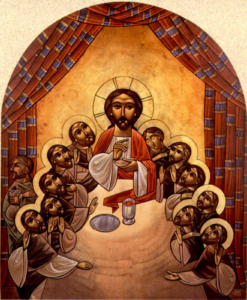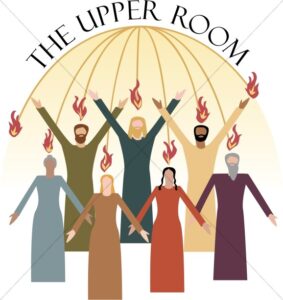“My Lord and my God!” – Echoes from The Upper Room

“He will show you a large room upstairs, furnished, and ready. Prepare for us there”.
The Upper Room was a significant site, that represented an illuminating iconic locus in the formation of Holy Church. Also known as ‘Cenacle’ (Sehion Mallika), on the upper slopes of Mount Zion was the venue of many important, transformative events in the early Church that holds immensely prime and inordinately precious quintessence for Orthodox Christians. The Upper Room has witnessed substantial spiritual encounters and crucial communal gatherings, that hold predominant theological and preeminent spiritual significance for us.
The Greek words ‘huperóon’ and ‘anagaion’ means upper rooms. Though this is brought to light in the New Testament, the Upper Room is mentioned in the Old Testament too. The ‘upper room’ was usually a room that was built on the first floor or roof of houses and was used as a place of prayer, as a dining room or guest room. David gave Solomon the plans for the Temple, mentioning an ‘upper room’. Those days upper rooms were only associated with temples and palaces, afforded, and occupied by priests, kings and the rich (1 Chron. 28: 11). Prophet Jeremiah curses those who built houses by unrighteousness and upper rooms by injustice (Jer. 22: 13-14).
Daniel often retreated into his upper room, a prayer room, as it was his custom and used it as a place of prayer and worship. He used to get down on his knees three times a day to pray to his God and praise Him (Dan. 6: 10). Miracles were wrought in the upper room entreating God’s power. Elijah raised the widow’s son and Elisha raised the Shunamite’s son in the upper room (1 Kings 17: 17-24; 2 Kings 4: 18-37). Sarah weeps in her upper room and beseeching the Lord in despair, with her prayers even being answered there (Tobit 3: 10). They all, prayed in the upper room and God answered their prayers. The Old Testament also mentions about the Upper Room in Judg. 3: 20; 2 Sam. 18: 33.
When Joseph and Mary arrived at their ancestral home in Bethlehem, they were told that all the rooms and upper rooms were occupied. In Luke 2: 7, we read that there was no room for Mary and Joseph in the inn (kataluma – Greek) means an upper room or guest room. Later, in the New Testament many of the events from the upper room echo down to us today. Key characters of the Christian doctrine have found their embryotic roots in the upper room. The Upper Room events uncovers and unwraps the fountainhead divine mysteries and wellspring significances of this sacred space and teach us about kernel morsels for our spiritual journeys.
The Upper Room belonged to Mary, mother of St. Mark (Acts 12: 12, 25; 15: 37). Mary, was deeply devoted to Jesus, was owner of the ‘upper room’. The family was highly pious, socially prominent and in close relationship with the Lord Jesus Christ. They were among the first to recognize Jesus Christ as the Messiah. John Mark was identified as the man who had been carrying the jar when the two disciples went to prepare a place for the celebration of the Institution of the Passover Meal (Mark 14:13-14; Luke 22:11). The first Biblical mention of St. Mark’s ministry is with St. Barnabas and St. Paul from Jerusalem to Antioch (Acts 12:25). St. Paul identifies St. Mark as the ‘cousin of Barnabas’ (Col. 4:10). John Mark’s mother Mary, who may be one of the unidentified Mary, at the foot of the Cross, played an important part in the early days of the Church in Jerusalem. She turned her more than adequate, spacious house into a headquarters for the New Faith, which in turn became focal point of the ministry of Apostles.

Echoes from the Upper Room
- The Upper Room was ‘full of Light’ as Christ the Light of the World was present (Jn. 12: 46)
- The Upper Room was the venue of the Last Supper (Lord’s Supper) Mk. 14: 15, Lk 22. 12).
- Our Lord Jesus Christ Himself, washed the feet of His own disciples. Thus the Upper Room is the first Christian Church in the world, where Christ taught true love and servanthood.
- Jesus instituted the Holy Eucharist (Mk 14: 12-26) and He gave us the New Covenant (Lk. 22: 20).
- Our Saviour Jesus shared His heart with His disciples, in what we know as the Farewell Discourse of John Ch. 13 to 17.
- It was here, He announced His betrayal and denial here (Jn. 12: 21; 13: 36) and foretold His death, glorification, and departure from this world (Jn. 13: 31, 32; 14: 13; 13; 1).
- Jesus reveals and emphasizes the “He is Way, the Truth and Life’ and that no one can go to the Father, except through Him (Jn. 14: 6)
- He promised the coming Holy Spirit; and they prayed in preparation for all that was to take place (Jn. 14: 16, 26).
- The place our Lord appeared to His disciples, twice after His Resurrection (Jn. 20: 19, 26).
- It is here the Risen Lord breathed on them the Holy Spirit “on the evening of that first day of the week” (John 20: 19).
- It was here that the Risen One made visible His wounds to see and touch, and the room where the faith of St. Thomas emerged. We Malankara Orthodox Christians ought to cherish and hold this Upper Room close to our hearts as the trademark catchword ‘My Lord and my God’ (Jn. 20: 28) that became a watchword for us, faithful.
- It was here, the disciples waited, prayed & received the Holy Spirit at Pentecost (Acts 1: 13, 2: 1).
- It was in this house, the disciples prayerfully selected St Matthias (Acts 1: 26).
- This was where the Church prayed collectively for, when Peter was imprisoned (Acts 12: 5).
- This sanctified dwelling was the house that Peter went to after being released from Herod’s prison by an angel of the Lord. (Acts 12: 4 – 12).
- This is where many gathered in one accord in prayer (Acts 12: 12).
- The Church where St James celebrated the First Holy Qurbana
Many of the events of the upper room echo down to us today. The upper room has transcended the description of a place but has become a sanctuary for Christians. All through scripture, the upper room has been a place of Prayer for God.

St. Mark’s mother opened her doors to all comers, and it is generally accepted that hers was the house to which the disciples went, the ‘Upper Room’ the holiest house in the world, where the disciples gathered after the Ascension & Pentecost Day. The upper room also proved to be the place of various meetings and miracles which strengthened and emboldened the faith of early Christians, empowering them to preach and perform miracles, that turned it as the site of a significant and transformative event in the early Church.
The Upper Room is a powerful symbol in the Christian faith, representing the congregational gathering of believers and the power of encountering God in our spiritual lives that serves as a reminder of the transformative power of faith and the divine transformation that it can bring to our lives. The Upper Room should not be limited to just a physical space but a sacred space, that should remind us of the power and significance, acceptance, and assurance of Christ. A place where believers can go to find spiritual discovery and to connect with their spiritual sacramental community.
As we continue our spiritual journey in life, may we all have an Upper Room in our homes to meet Christ, to have a personal encounter with Christ, to guide and inspire us on our path towards divine transformation to unite with Christ. Let this be, the place and space, where we enjoy the quiet time in the company and communion of Christ, the merging and melding with Christ, in union and unison to Christ. A personal, favoured prayer place, set apart from the hustle, bustle, and rigmaroles of our busy life, where we commune with God and He communes with you.
May the Holy Spirit fill us and guide us, enable, and empower us to preach to the world and spread His gospel. Amen.
0 Comments